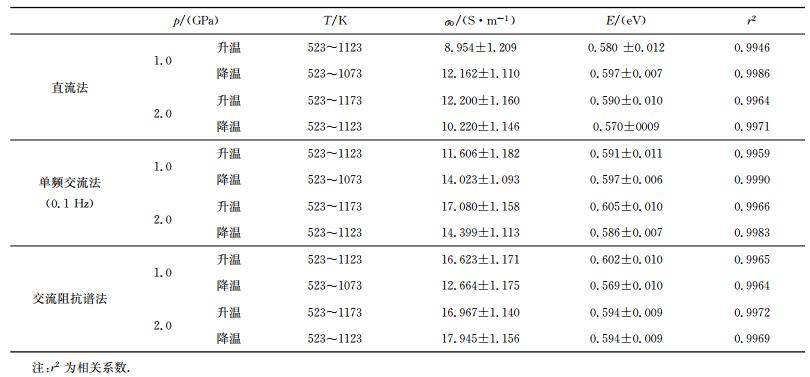2. 中国科学院研究生院, 北京 100049
2. Graduate School of Chinese Academy of Sciences, Beijing 100049, China
在高温高压下研究岩石和矿物的电导率是了解地球深部物质的组成、结构构造、传导机制、物质的运动变化状态的重要手段,也是对已有的大地电磁测深结果进行合理解释的不可缺少的基础[1].
高温高压下,岩石和矿物电导率测量方法主要有:直流法[2]、单频交流法[3~5]和交流阻抗谱法[6, 7](在下文的叙述中分别简称为DC、SF和IS).以往的研究中,大多是采用单一的一种方法研究岩石和矿物电导率.那么,如果在相同条件下,同时采用直流法、单频交流法和交流阻抗谱法测量同一块岩石的电导率,其结果究竟有何差别?
高温高压下,对于地幔各种矿物和岩石在干的和不同水饱和度条件下的电导率实验研究比较多[4, 8~13];对于地壳矿物岩石电导率的实验研究则主要集中在对高导层的成因解释上[14~16],但是对中下地壳各种岩石类型电导率的实验研究并不多[17, 18],尤其是对下地壳代表性岩石麻粒岩的研究报道更是相对较少[19].麻粒岩相变质岩通常被认为是大陆下地壳的主要组成岩石,主要依据为:麻粒相岩石的变质条件与大陆下地壳的温压条件相当[20, 21],同时高温高压下麻粒岩相岩石的弹性波速度研究的结果也表明大多数基性麻粒岩的弹性波速与下地壳的弹性波速相吻合[22].但是依据实验测量获得的麻粒岩电导率建立的电导率-深度剖面是否与野外大地电磁测深获得的下地壳电导率一致呢?
针对上述两个问题,我们在1.0 GPa、523~1123 K和2.0 GPa、523~1173 K条件下,同时使用DC、SF(0.1 Hz)和IS三种方法测量了产出于华北克拉通北缘张家口地区的二辉麻粒岩的电导率,重点讨论了:(1)高压下DC、SF(0.1 Hz)和IS测量岩石电导率获得的结果是否相同?(2)依据实验获得的岩石电导率建立的电导率-深度剖面与大地电磁测深结果相对比,得出的结论是否与依据岩石弹性波速度-深度剖面与地震折射剖面对比得出的结论一致?
2 实验过程 2.1 样品准备实验样品采自华北北缘河北省张家口地区宣化西望山.样品新鲜,灰黑色,致密块状构造.主要组成:斜长石(41%)、单斜辉石(22%)、斜方辉石(20%),少量角闪石(7%)、石榴石(6%)和黑云母(2%),副矿物有榍石(1%),其他(1%),粒度小于0.3 mm.其完整的岩石学定名为角闪二辉斜长麻粒岩,简称为二辉麻粒岩.样品的全岩和主要矿物的化学成分参见表 1(据姜能未发表资料).实验样品先磨制成直径6.0±0.1 mm的长圆柱体,然后用低速锯切成高为2.66 mm的圆柱,清洗好样品,放入323 K烘箱中烘干,然后放入473 K的烘箱里烘烤至少10 h,以尽量去除样品的吸附水.
|
|
表 1 实验样品的全岩和主要矿物主量元素成分(Wt%) Table 1 Major element compositions of the sample and its main minerals (wt%) |
高压实验是在中国科学院地球化学研究所地球深部物质与流体作用地球化学实验室的YJ-3000t紧装式六面顶压机上完成的,该系统的详细介绍参见文献[23].实验样品装置如图 1,传压介质用立方体叶蜡石粉压块(边长32.5±0.5 mm),将其焙烧至1123 K以避免叶蜡石脱水给实验测量带来影响.样品和加热器之间用Al2O3和MgO管绝缘,加热器采用3层不锈钢片,电极为直径为6 mm、厚0.1 mm钼片,实验过程中的氧逸度接近于Mo-MoO2氧逸度.采用NiCr-NiSi热电偶测量温度,样品温度测量的误差小于±5 K.
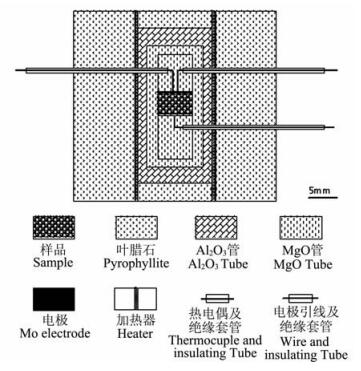
|
图 1 实验样品装置图 Fig. 1 Schematic drawing of the experimental sample assembly |
实验采用恒定压力、升高温度的方式,测量了升温和降温过程中样品的直流电阻、单频交流电阻(0.1 Hz)和交流阻抗谱.首先手动将压力升高到目标压力,在保持恒定压力的条件下(误差±0.1 GPa),升温至待测温度(误差±5 K),恒温至少0.5h以使体系的温度接近平衡,运行Solartron-IS1260阻抗/增益-相位分析仪(测量精度0.05%)的ZPlot程序,在0.05~106 Hz频率范围内测量样品不同频率下的实部、虚部、模和相角.阻抗谱测量完成后,利用Agilent 34401 A数字电表测量样品的直流电阻(每个温度点上测量10个直流电阻值,求平均值).对于单频交流电导是选取交流阻抗谱扫频测量的复阻抗在0.1 Hz的实部值作为样品在频率0.1 Hz下的电阻值,计算出样品的单频交流电导率.每隔50 K就重复上述程序,同时测量样品的直流电阻、单频交流电阻(0.1 Hz)和交流阻抗谱.实验的压力范围为1.0~2.0 GPa,温度范围为523~1173 K.
3 实验结果 3.1 阻抗谱的特征实验获得了二辉麻粒岩在1.0 GPa、523~1123 K和2.0 GPa、523~1173 K条件下,升温和降温过程中的阻抗谱、单频交流电阻值和直流电阻值.样品在实验前后没有发生部分熔融(邢印锁等未发表资料,2009),因此实验数据反应了二辉麻粒岩的本征电学性质.图 2给出了样品在2 GPa、523~1173 K升温条件下的阻抗谱,其他条件下获得的阻抗谱与此类似.
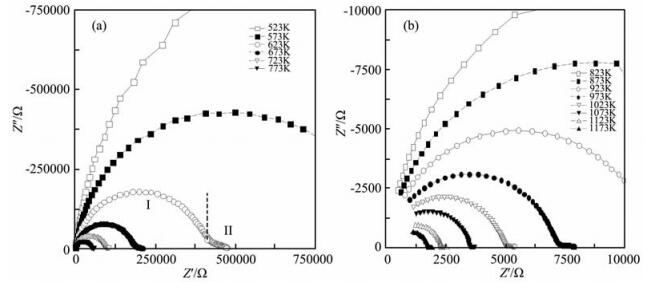
|
图 2 2.0 GPa、523~1173 K升温过程二辉斜长麻粒岩的阻抗谱图, Z′, Z″分别是复阻抗的实部和虚部, 图中标示了在2.0 GPa、623 K弧Ⅰ和弧Ⅱ, 说明见正文. Z′, Z″:Real and Imaginary part of the complex impedance.Arc Ⅰ and Ⅱ at 2.0 GPa and 623 K are marked in the figures, as explained in the text. Fig. 2 Impedance spectroscopy of two-pyroxene granulite at 2.0 GPa and 523~1173 K during the heating process. |
在实验温度和压力范围内,样品的阻抗谱都是由一个大的半圆弧Ⅰ和一个小的被压缩的弧Ⅱ组成(如图 2a中在2.0 GPa、623 K的阻抗谱所示).弧Ⅰ主要代表样品矿物颗粒内部的传导机制,出现于高频段,圆弧过原点且圆心落在实轴的下部,其直径代表着样品的直流电阻值[24, 25].在同一压力下,随着温度的升高,阻抗谱向原点移动,其实部和虚部都大幅度变小且变的越来越规则.由于实验采用的频率最低为0.05 Hz,所以弧Ⅱ只出现了一小部分.它代表着样品与电极之间的传导机制并没有反应样品本身的电导性质.
3.2 数据处理对于直流电导,我们直接计算升温和降温过程中每个温度点上测量的10个直流电阻值的平均值,将其代入公式(1)计算样品的电导率值:

|
(1) |
式中σ表示电导率(S/m),L表示样品长度(m),S表示电极的横截面积(m2),R表示样品的电阻(Ω).
对于交流阻抗谱,我们以等效电路原理为基础(图 3),利用ZView程序来分析和拟合获得的阻抗谱,从而获得样品的电阻(R1)和常相角元素(CPE1)的值.其电阻的拟合误差小于1%,常相角元素的拟合误差小于0.5%.将所获得电阻值代入公式(1),就得到了样品的电导率.

|
图 3 等效电路图.等效电路由两个RC电路串联组成, 以常相角元素CPE代替了电容.其中R1与CPE1并联反映了样品颗粒内部的传导机制, R1代表样品的直流电阻; R2与CPE2并联代表样品与电极之间的效应 Fig. 3 The equivalent circuit.The equivalent circuit consists of two parallel RC circuit elements connected in series.The parallel of R1 and CPE1 corresponds to the intrinsic conduction mechanism of sample and R1 stands for the DC intrinsic resistance of the sample, the parallel of R2 and CPE2 relates to electrode properties |
对于单频交流电导率,我们直接选取交流阻抗谱扫频测量过程中获得的复阻抗在0.1 Hz的实部值,作为样品在频率0.1 Hz下的电阻值,再将其代入公式(1)计算出样品的单频交流电导率.
3.3 结果在1.0~2.0 GPa,523~1173 K条件下,3种方法测得的二辉麻粒岩电导率随温度升高而增大.电导率的对数值(lgσ)与温度的倒数(10000/T)呈现良好的线性关系(图 4),符合Arrhenius关系式:

|
图 4 1.0~2.0 GPa, 523~1123 K下升温和降温过程中二辉斜长麻粒岩lgσ与1/T的关系图, 图中直线根据Arrhenius公式拟合的直线.(a)直流法测量结果; b)单频交流法(0.1 HZ)测量结果; (c)阻抗谱法测量结果. Fig. 4 Electrical conductivity versus 1/T at 1.0~2.0 GPa, 523~1123 K for the two-pyroxene granulite.The straight lines were fitted on the basis of the Arrhenius formula.(a) The result of DC-met hod; (b) The result at 0.1 Hz; (c) The result by using the impedance spectroscopy. |
其中σ0表示独立于温度的指前因子(S/m),κ为Boltzmann常数(J/K),T为热力学温度(K),ΔE为活化能(eV).二辉麻粒岩电导率Arrhenius关系式拟合参数见表 2.
|
|
表 2 二辉麻粒岩电导率的Arrhenius关系式拟合参数 Table 2 Fitted parameters of Anrhenius formula for the electrical conductivity of two-pyroxene granulite |
Fuji-ta等[19]在1.0 GPa,室温至900 K(相当于中下地壳温压)条件下利用SF(0.01 Hz)对日本HMB变质带的热压麻粒岩进行了3个升温-降温过程的电导率测量.依据实验结果,他们认为在570~870 K的温度范围,热压麻粒岩的电导率是稳定的,其值变化于4.9×10-4~5.9×10-3 S/m之间.在相同的温度压力范围内,我们获得的二辉麻粒岩的SF(0.1 Hz)电导率为8.4×10-5~4.8×10-3 S/m,与Fuji-ta等[19]获得的热压麻粒岩的SF电导率比较接近.
三种方法获得的样品的活化能非常接近(0.569~0.605 eV).与王多君[26]在1.0 GPa,593~893 K获得的辉长岩的活化能0.67 eV、黄晓葛等[18]在1.0 GPa,低温段(523~973 K)获得的片麻岩的活化能0.53 eV相近;但高于白利平等[27]在1.0~2.0 GPa,室温至1373 K获得的辉长岩的活化能(分别为0.38 eV和0.34 eV),也高于Fuji-ta等[28]在1.0 GPa、600~1000 K获得的片麻岩的活化能0.24~0.27 eV;低于Partzsch等[29]在常压,873~1473 K获得的麻粒岩的活化能1.40 eV.
4 讨论 4.1 压力对电导率的影响对于高温高压条件下的岩石电导率来说,多种传导机制可能同时起作用,如离子传导、空穴传导、杂质传导以及极化子传导等等[30, 31].压力对电导率的不同传导机制的影响是不同的.一般的,对于离子-电子混合传导机制,压力对电导率的影响可以相互抵消,因而,压力对电导率的影响可能很小[32].在我们的实验中(图 4),相同温度条件下,2.0 GPa的电导率数据一般稍稍大于1.0 GPa的电导率数据.但是总的来看,无论使用哪种方法,在相同的温度,不同的压力条件下,不管是升温还是降温时的电导率数据,其差别非常小(<5.2%).如在873 K,压力1.0 GPa降温过程,DC、SF(0.1 Hz)和IS测得的二辉麻粒岩的电导率分别为-2.381、-2.317和-2.218 lgS/m、而压力为2.0 GPa降温过程,三种方法测得的二辉麻粒岩的电导率为-2.321、-2.257和-2.248 lgS/m,相同方法获得的测量值分别相差2.6%、2.6%、0.4%.因此,可以认为在我们的实验温度压力范围内,压力对二辉麻粒岩的电导率无明显影响.
4.2 三种测量方法获得结果的对比 4.2.1 高温高压下测量岩石电导率的方法如前所述,高温高压下测量岩石电导率的方法主要有三种:直流法(DC)、单频交流法(SF)和交流阻抗谱法(IS).
早期的研究主要采用DC测量岩石的电导率[33].随着研究的深入,现在一般认为,在电场的作用下,电极会发生极化作用,同时高温高压下电极与样品也可能会发生反应[34].另外,外部电路对DC测量也可能会产生影响.由于DC测量岩石的电导率无法消除这三方面的影响,因此,现在已经很少有学者采用DC测量岩石的电导率.
单频交流法(SF)是采用单一频率的交流电场来测量岩石的电导率(通常采用小于0.1 Hz的频率).单频交流电能够消除样品的极化效应,同时采用低频可以避免加热电源频率的信号干扰,并能够消除电容的影响[19].再者,采用单低频测量岩石的电导率也与大地电磁测深采用的低频范围(10-2~10-5 Hz)接近.例如魏文博等[35, 36]对山西应县-山东商河大地电磁测探的时候,所采集到的MT信号频率范围为3.2×10-2~4.6×10-4 Hz.因此采用低频下的实验研究结果与大地电磁测深所获得的结果相比较才是有意义的.但是,目前广泛认为SF无法消除实验过程中存在的电极-界面阻抗的影响[37, 38].
交流阻抗谱法(IS)被引入高温高压下岩石电导率测量被认为是目前最为先进的测量方法[39].这一测量方法能够有效区分样品的电阻和电容,以及样品-电极界面的接触电阻和微分电容等,从而能够有效避免上述两种方法的缺陷,成为近年来高温高压下电导率测量的主要方法.
4.2.2 不同测量方法的结果对比尽管IS被认为是目前高温高压下岩石电导率最先进的测量方法,但是,直接对比上述三种测量方法获得的实验结果的研究尚未见报道.本次实验中,我们同时使用了以上三种方法测量了二辉麻粒岩的电导率.
由前一小节的介绍可以知道,从理论上来看,DC测量结果有可能包含了外部电路、电极极化和电极-样品间反应的影响,其测量的电阻率值有可能偏大,从而最后获得的电导率值偏小.利用IS进行测量电导率,同时采用合理的等效电路来拟合获得的阻抗谱,可以有效地消除外部电路、电极极化和电极-样品间反应的影响,其测量结果不包含上述3方面的影响,因此获得的电阻率值最小,电导率值最大.SF(0.1 Hz)的测量结果虽然消除了外部电路和电极极化的影响,但是仍然包含了电极-样品间阻抗界面的影响,因此,SF(0.1 Hz)测得的电导率值居中.
无论从理论上,还是我们的实验结果来看(见图 5),DC测量结果<SF(0.1 Hz)测量结果<IS测量结果,除图 5b外,在高温段差值相对较大.但是,三种方法获得的电导率差值除两个低温点外,绝大多数都很小(Δlgσ<0.20 lg(S/m)).具体而言,DC与IS结果差值变化范围1.1%~13.2%,平均5.7%;SF与IS差值范围7.3%~0.9%之间,平均3.3%;DC与SF差值范围0.1%~7.8%,平均2.2%.这一结果也与Karato和Dai[37]的结果一致.
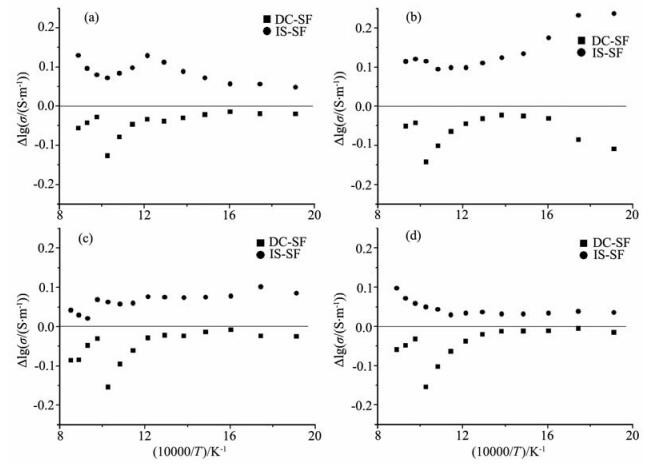
|
图 5 Δlg σDC-SF和Δlg σIS-SF与1/T的关系图.Δlg σDC-SF为直流法(DC)与单频父流法(SF)测量结果的差值(DC-SF); Δlg σIS-SF为阻抗谱法(IS)与SF的差值(IS-SF).图中直线为SF-SF.(a)1.0 GPa、523~1123 K, 升温过程; (b)1.0 GPa、523~1073 K降温过程; (c)2.0 GPa、523~1173 K升温过程; (d)2.0 GPa、523~1123 K降温过程 Fig. 5 Δlg σDC-SF and Δlg σIS-SF versus 1/T for two-pyroxene granulite.The Δlg σDC-SF and Δlg σIS-SF respectively represent the difference between DC and SF, IS and SF.The straight lines stand for the value of SF-SF.The electrical conductivity was obtained by the DC-method (DC), 0.1 Hz (SF), and impedance spectroscopy (IS), respectively at the 1.0~2.0 GPa and 523~1123 K.(a)1.0 GPa, 523~1123 K, during heating process; (b)1.0 GPa, 523~1073 K during cooling process; (c)2.0 GPa, 523~1173 K during heating process; (d)2.0 GPa, 523~1123 K during cooling process |
Karato和Dai[37, 40]在15 GPa、873~1273 K条件下同时采用IS测量了含水和不含水wadsleyite的电导率,并选取了频率为0.01 Hz时的电导率与IS测量的结果进行了比较.结果显示SF(0.01 Hz)测量结果<IS测量结果,且在高温段和高含水量样品中,两种方法获得的电导率结果的差值更大,因此他们认为采用不同方法(SF(0.01 Hz)与IS)测量的结果来推断地幔过渡带中水的存在对电导率影响时,二者会产生很大的差异.但是Manthilake等和Yoshino等[3, 41]的实验结果却与Karato和Dai[37, 40]的实验结果不一样.Manthilake等和Yoshino等[3, 41]在16 GPa、700~1000 K条件下采用SF(0.1 Hz)测量了含水和不含水wadsleyite的电导率并与IS测量的结果进行了对比.他们的结果显示采用SF(0.1 Hz)的测量结果要比采用SF(0.01 Hz)的测量结果更接近于IS法测得的电导率.SF(0.1 Hz)获得的结果与IS的结果相差非常小,可以忽略不计.
4.3 与大地电磁测深的电导率对比依据Arrhenius公式的指前因子和活化能(表 2),结合华北克拉通温度随深度的变化关系式(3)和华北地壳结构(表 3),求得二辉麻粒岩的电导率随深度的变化剖面.其中温度随深度变化关系式为:
|
|
表 3 华北克拉通地壳分层结构及各层温度计算参数[43, 44] Table 3 Crustal layers structure and thermal calculation parameters in the North China craton |

|
(3) |
T为温度(K);z为深度(m);T0为地表温度(K),κ为岩石热导率(Wm-1·K-1),q0为地表热流(mW·m-2);A为岩石生热率(μW·m-3).
依据三种方法测量的二辉麻粒岩在1.0 GPa,523~1123 K降温过程的电导率数据计算的电导率-深度曲线表示在图 6.依据三种方法测量的二辉麻粒岩在1.0 GPa,523~1123 K升温过程以及2.0 GPa,523~1173 K升温和降温过程计算的电导率-深度曲线与此类似.图 6中还表示了华北地区张家口-蓬莱构造带的大地电磁测深剖面获得的上中下地壳的电导率范围[42].
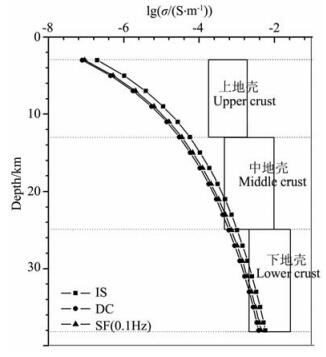
|
图 6 在l GPa、523~1123 K降温过程, 三种方法获得的二辉麻粒岩电导率-深度剖面与区域地壳电性结构对比.DC为直流法测量结果; SF (0.1 HZ)为单频交流法测量结果; S为阻抗谱法测量结果 Fig. 6 Comparison between the two-pyroxene granulite electrical conductivity verse depth profile of three methods and electromagnetic structure for this area.The electrical conductivity used for constructed the electrical conductivity verse depth was measured at 1 GPa, 523~1123 K during cooling process.DC is the result of DC-method; SF (0.1 Hz) is the result at 0.1 Hz; IS is the result by using the impedance spectroscopy |
由图 6可以看出,实验获得的二辉麻粒岩电导率-深度曲线与中地壳下部的电导率范围以及下地壳中下部的电导率范围相交,因此,单纯从电导率的结果来看,二辉麻粒岩可能为现今华北克拉通北缘中地壳底部和下地壳底部的岩石组成之一.
Kern等[22]在常压至600 MPa,室温至873 K条件下测量了采自华北克拉通的12块代表性岩石的弹性波速度.这12块岩石涵盖了华北地区最主要的岩石类型,包括变流纹岩、TTG片麻岩、变质杂砂岩、斜长角闪岩、铁镁质麻粒岩等.依据其实验结果,结合华北克拉通地温曲线和华北地区地壳分层结构,Kern等[22]计算了每种岩石的速度-深度曲线并将其与80年代晚期国内做的华北地区的地震折射剖面结果[45]进行了对比.他们认为华北克拉通下地壳上部岩石主要由铁镁质麻粒岩组成的,而代表着下地壳最底部高波速(>7.0 km/s)的岩石并未出露于地表.另外,Kern等[22]还发现在华北地区,岩石的纵波速度与其SiO2存在明显的线性关系,随着SiO2百分含量的增多,纵波速度逐渐减小(图 7).我们的实验样品SiO2百分含量为51.24%(表 1).采用内插法将我们实验所用的二辉麻粒岩样品标绘在Kern等给出的SiO2-纵波速度-深度图上,其纵波速度落入下地壳底部的范围(图 7).因此,综合二辉麻粒岩的电导率和纵波速度对比结果,我们认为华北北缘张家口地区的地体二辉麻粒岩为现今下地壳岩石组成之一.
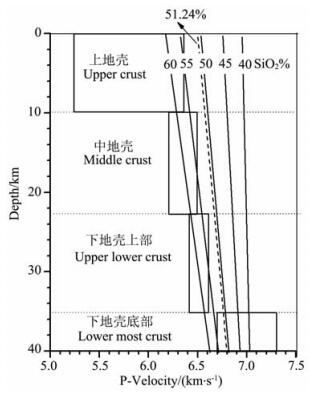
|
图 7 岩石SiO2含量的弹性波速度-深度剖面图及上中下地壳波速范围(据Kern等1996)[22].虚线为采用内插法计算的本次实验的二辉麻粒岩样品(SiO2含量为51.24%)的弹性波速度.从图中可以看出计算的二辉麻粒岩弹性波速度(图中的虚线)与下地壳下部的弹性波速度范围相交 Fig. 7 Comparison between seismic structure and velocity-depth profiles along with lines of constant bulk SiO2 content.Outlined blocks indicate ranges of P wave velocities for various crustal layers of the study area from seismic refraction experiments (After Kern et al., 1996)[22].The SiO2 content of the two-pyroxene granulite in the study is 51.24%, and the calculation Vp of the two-pyroxene granulite (the dash Hne m the figure) falls into the range of the Vp of the lower most crust |
(1) 在1.0~2.0 GPa,523~1173 K条件下,随着温度的升高,二辉麻粒岩的电导率增大,符合Arrhenius关系式.
(2) 在1.0~2.0 GPa,523~1173 K的温压范围内,压力对二辉麻粒岩的电导率没有明显的影响.
(3) 在相同的条件下,直流法、单频交流法(0.1 Hz)和交流阻抗谱法获得的二辉麻粒岩的电导率依次增大.在1.0~2.0 GPa,523~1173 K条件下,三种方法获得的电导率差值除两个低温点外,绝大多数都很小(Δlgσ<0.20 lgS/m).
(4) 依据实验获得的二辉麻粒岩的电导率实验结果与野外大地电磁测深剖面对比,结合实验弹性波速度与地震折射剖面的对比结果,可以认为华北北缘张家口地区二辉麻粒岩为现今下地壳岩石组成之一.
| [1] | Lastovickova M. A review of laboratory measurements of the electrical-conductivity of rocks and minerals. Physics of the Earth and Planetary Interiors , 1991, 66(1-2): 1-11. DOI:10.1016/0031-9201(91)90099-4 |
| [2] | Duba A, BolandJ N, Ringwood A E. Electrical-conductivity of pyroxene. Journal of Geology , 1973, 81(6): 727-735. DOI:10.1086/627925 |
| [3] | Manthilake M A G M, Matsuzaki T, Yoshino T, et al. Electrical conductivity of wadsleyite as a function of temperature and water content. Physics of the Earth and Planetary Interiors , 2009, 174(1-4): 10-18. DOI:10.1016/j.pepi.2008.06.001 |
| [4] | Constable S, Shankland T J, Duba A. The electrical-conductivity of an isotropic olivine mantle. Journal of Geophysical Research-Solid Earth , 1992, 97(B3): 3397-3404. DOI:10.1029/91JB02453 |
| [5] | Lastovickova M. Laboratory measurements of electrical-conductivity of biotites. Studia Geophysica Et Geodaetica , 1991, 35(2): 125-129. DOI:10.1007/BF01628078 |
| [6] | Roberts J J, Tyburczy J A. Frequency-dependent electrical-properties of dunite as functions of temperature and oxygen fugacity. Physics and Chemistry of Minerals , 1993, 19(8): 545-561. |
| [7] | Dai L D, Li H P, Liu C G, et al. Experimental measurement of the electrical conductivity of single crystal olivine at high temperature and high pressure under different oxygen fugacities. Progress in Natural Science , 2006, 16(4): 387-393. DOI:10.1080/10020070612330009 |
| [8] | Xu Y S, Poe B T, Shankland T J, et al. Electrical conductivity of olivine, wadsleyite, and ringwoodite under upper-mantle conditions. Science , 1998, 280(5368): 1415-1418. DOI:10.1126/science.280.5368.1415 |
| [9] | Xu Y, Shankland T J, Duba A G. Pressure effect on electrical conductivity of mantle olivine. Physics of the Earth and Planetary Interiors , 2000, 118(1-2): 149-161. DOI:10.1016/S0031-9201(99)00135-1 |
| [10] | Huang X G, Bai W M, Xu Y S, et al. Influence of hydrogen on electrical conductivity of wadsleyite and ringwoodite with its geodynamics implications. Acta Petrologica Sinica , 2005, 21(6): 1743-1748. |
| [11] | Romano C, Poe B T, Tyburczy J, et al. Electrical conductivity of hydrous wadsleyite. European Journal of Mineralogy , 2009, 21(3): 615-622. DOI:10.1127/0935-1221/2009/0021-1933 |
| [12] | Yoshino T, Manthilake G, Matsuzaki T, et al. Dry mantle transition zone inferred from the conductivity of wadsleyite and ringwoodite. Nature , 2008, 451(7176): 326-329. DOI:10.1038/nature06427 |
| [13] | Huang X G, Xu Y S, Karato S I. Water content in the transition zone from electrical conductivity of wadsleyite and ringwoodite. Nature , 2005, 434(7034): 746-749. DOI:10.1038/nature03426 |
| [14] | Glover P W J, Vine F J. Electrical-conductivity of carbon-bearing granulite at raised temperatures and pressures. Nature , 1992, 360(6406): 723-726. DOI:10.1038/360723a0 |
| [15] | Freund F. On the electrical conductivity structure of the stable continental crust. Journal of Geodynamics , 2003, 35(3): 353-388. DOI:10.1016/S0264-3707(02)00154-0 |
| [16] | Schilling F R, Partzsch G M, Brasse H, et al. Partial melting below the magmatic arc in the central Andes deduced from geoelectromagnetic field experiments and laboratory data. Physics of the Earth and Planetary Interiors , 1997, 103(1-2): 17-31. |
| [17] | Glover P W J, Vine F J. Beyond ktb-electrical-conductivity of the deep continental-crust. Surveys in Geophysics , 1995, 16(1): 5-36. DOI:10.1007/BF00682710 |
| [18] | 黄晓葛, 白武明, 周文戈. 高温高压下黑云斜长片麻岩的电性研究. 高压物理学报 , 2008, 22(3): 237–244. Huang X G, Bai W M, Zhou W G. Experimental study on electrical conductivity of biotite-and plagioclase-bearing gneiss at high temperature and high pressure. Chinese Journal of High Pressure Physics. (in Chinese) , 2008, 22(3): 237-244. |
| [19] | Fuji-ta K, Katsura T, Tainosho Y. Electrical conductivity measurement of granulite under mid-to lower crustal pressure-temperature conditions. Geophysical Journal International , 2004, 157(1): 79-86. DOI:10.1111/gji.2004.157.issue-1 |
| [20] | Rudnick R L, Fountain D M. Nature and composition of the continental-crust-a lower crustal perspective. Reviews of Geophysics , 1995, 33(3): 267-309. DOI:10.1029/95RG01302 |
| [21] | 翟明国, 刘文军. 麻粒岩的形成及其对大陆地壳演化的贡献. 岩石学报 , 2001, 17(1): 28–38. Zhai M G, Liu W J. The formation of granulite and its contribution to evolution of the continental crust. Acta Petrologica Sinica. (in Chinese) , 2001, 17(1): 28-38. |
| [22] | Kern H, Gao S, Liu Q S. Seismic properties and densities of middle and lower crustal rocks exposed along the North China Geoscience Transect. Earth and Planetary Science Letters , 1996, 139(3-4): 439-455. DOI:10.1016/0012-821X(95)00240-D |
| [23] | 谢鸿森, 张月明, 徐惠刚, 等. 高温超高压下测量岩石矿物弹性波速的新方法及其地学意义. 中国科学(B辑) , 1993, 36(10): 1276–1280. Xie H S, Zhang Y M, Xu H G, et al. A new method of measurement for elastic wave velocities in minerals and rocks at high temperature and high pressure and its significance. Science in China (Ser. B) (in Chinese) , 1993, 36(10): 1276-1280. |
| [24] | Roberts J J, Tyburczy J A. Frequency-dependent electrical-properties of minerals and partial-melts. Surveys in Geophysics , 1994, 15(2): 239-262. DOI:10.1007/BF00689861 |
| [25] | Huebner J S, Dillenburg R G. Impedance spectra of hot, dry silicate minerals and rock-qualitative interpretation of spectra. American Mineralogist , 1995, 80(1-2): 46-64. DOI:10.2138/am-1995-1-206 |
| [26] | 王多君, 李和平, 刘丛强, 等. 高温高压下辉长岩的电导率实验研究. 矿物学报 , 2002, 22(1): 81–84. Wang D J, Li H P, Liu C Q, et al. The electrical conductivity of at high temperture and pressure. Acta Mineralogica Sinica (in Chinese) , 2002, 22(1): 81-84. |
| [27] | 白利平, 杜建国, 刘巍, 等. 高温高压下辉长岩纵波速度与电导率实验研究. 中国科学(D辑) , 2002, 32(11): 959–968. Bai L P, Du J G, Liu W, et al. The experimental studies on electrical conductivities and P-wave velocities of gabbro at high pressure and high temperature. Science in China, Ser. D. (in Chinese) , 2002, 32(11): 959-968. |
| [28] | Fuji-ta K, Katsura T, Matsuzaki T, et al. Electrical conductivity measurement of gneiss under mid-to lower crustal P-T conditions. Tectonophysics , 2007, 434(1-4): 93-101. DOI:10.1016/j.tecto.2007.02.004 |
| [29] | Partzsch G M, Schilling F R, Arndt J. The influence of partial melting on the electrical behavior of crustal rocks:laboratory examinations, model calculations and geological interpretations. Tectonophysics , 2000, 317(3-4): 189-203. DOI:10.1016/S0040-1951(99)00320-0 |
| [30] | Nover G. Electrical properties of crustal and mantle rocks-A review of laboratory measurements and their explanation. Surveys in Geophysics , 2005, 26(5): 593-651. DOI:10.1007/s10712-005-1759-6 |
| [31] | Nover G, Heikamp S, Kontny A, et al. The effect of pressure on the electrical-conductivity of Ktb Rocks. Surveys in Geophysics , 1995, 16(1): 63-81. DOI:10.1007/BF00682713 |
| [32] | 朱茂旭, 谢鸿森. 地球深部物质电学性质实验研究. 地球科学进展 , 1998, 13(5): 438–446. Zhu M X, Xie H S. Experimental researches of electrical characteristics on earth's deep interior materials. Advance in Earth Science (in Chinese) , 1998, 13(5): 438-446. |
| [33] | Duba A, Heard H C, Schock R N. Electrical-conductivity of olivine at high-pressure and under controlled oxygen fugacity. Journal of Geophysical Research , 1974, 79(11): 1667-1673. DOI:10.1029/JB079i011p01667 |
| [34] | 代立东, 李和平, 刘丛强, 等. 高温高压下二辉橄榄岩的阻抗谱实验研究. 高压物理学报 , 2005, 19(1): 29–34. Dai L D, Li H P, Liu C Q, et al. Experimental study on impedance spectra of iherzolite under high temperature and high pressure. Chinese Journal of High Pressure Physics (in Chinese) , 2005, 19(1): 29-34. |
| [35] | 魏文博, 金胜, 叶高峰, 等. 华北地区大地电磁测深及岩石圈厚度讨论. 中国地质 , 2006, 33(4): 762–772. Wei W B, Jin S, Ye G F, et al. MT sounding and lithosphere thickness in North China. Geology in China (in Chinese) , 2006, 33(4): 762-772. |
| [36] | 魏文博, 谭捍东, 金胜, 等. 华北中部岩石圈电性结构-应县-商河剖面大地电磁测深研究. 地球科学:中国地质大学学报 , 2002, 27(5): 645–650. Wei W B, Tan H D, Jin S, et al. Conductivity structure of lithosphere in central north China:Magnetotelluric study of Yingxian-Shanghe profile. Earth Science-Journal of China University of Geosciences (in Chinese) , 2002, 27(5): 645-650. |
| [37] | Karato S, Dai L D. Comments on "Electrical conductivity of wadsleyite as a function of temperature and water content″ by Manthilake et al. Physics of the Earth and Planetary Interiors , 2009, 74(1-4): 19-21. |
| [38] | Roberts J J, Tyburczy J A. Frequency-dependent electrical-properties of polycrystalline olivine compacts. Journal of Geophysical Research-Solid Earth , 1991, 96(B10): 16205-16222. DOI:10.1029/91JB01574 |
| [39] | 代立东, 李和平, 刘丛强, 等. 高温高压和控制氧逸度条件下透辉石电导率的各向异性实验研究. 岩石学报 , 2005, 1(6): 1737–1742. Dai L D, Li H P, Liu C Q, et al. In situ control of oxygen fugacity experimental study on the crystallograghic anisotropy of the electrical conductivities of diopside at high temperature and high pressure. Acta Petrologica Sinica (in Chinese) , 2005, 1(6): 1737-1742. |
| [40] | Dai L, Karato S I. Electrical conductivity of wadsleyite at high temperatures and high pressures. Earth and Planetary Science Letters , 2009, 287(1-2): 277-283. DOI:10.1016/j.epsl.2009.08.012 |
| [41] | Yoshino T, Katsura T. Reply to Comments on "Electrical conductivity of wadsleyite as a function of temperature and water content″ by Manthilake et al. Discussion. Physics of the Earth and Planetary Interiors , 2009, 174(1-4): 22-23. DOI:10.1016/j.pepi.2009.01.012 |
| [42] | 赵国泽, 刘国栋. 张北-尚义地震及其邻区地壳上地幔结构. 地震地质 , 1998, 20(2): 155–156. Zhao G Z, Liu G D. The structure of the crust and uppermantle for the Zhangbei-Shangyi seismic area and its neighbouring region. Seismology and Geology (in Chinese) , 1998, 20(2): 155-156. |
| [43] | 臧绍先, 刘永刚, 宁杰远. 华北地区岩石圈热结构的研究. 地球物理学报 , 2002, 45(1): 56–66. Zang S X, Liu Y G, Ning J Y. Thermal structure of the lithosphere in North China. Chinese J. Geophys. (in Chinese) , 2002, 45(1): 56-66. |
| [44] | 迟清华, 鄢明才. 华北地台岩石放射性元素与现代大陆岩石圈热结构和温度分布. 地球物理学报 , 1998, 41(1): 38–48. Chi Q H, Yan M C. Radioactive elements of rocks in North China platform and the thermal structure and temperature distribution of the modern continental lithosphere. Chinese J. Geophys. (Acta Geophysica Sinica) (in Chinese) , 1998, 41(1): 38-48. |
| [45] | Ma X Y, Liu C Q, Liu G D. The geoscience transect from Xiangshui, Jiangsu province to Mandal, Inner mongolia. Acta Geologica Sinica , 1992, 5(1): 1-21. |
 2010, Vol. 53
2010, Vol. 53




